|
Dr. Choi receives 2026 AMPP Fellow Honor
|
Dr. Yoon-Seok Choi, Research Professor and ICMT Associate Director for Research, will receive the 2026 AMPP Fellows Honor at the March 18 Awards Ceremony in Houston, Texas.
Dr. Choi's most important contributions center on advancing both the fundamental and applied understanding of corrosion in CO2 transport pipelines,
particularly under conditions relevant to carbon capture, utilization, and storage (CCUS) infrastructure. Since 2008,
Dr. Choi has orchestrated research that provided first-of-their-kind insights into corrosion processes in supercritical CO2 environments with NOx/SOx/O2/H2O
impurities that behave synergistically. These studies, conducted through individual and multi-company research projects at the ICMT,
identified key mechanistic pathways of degradation, allowing engineers in the field to move from empirical observations toward mechanistic understanding;
he leads ICMT's ongoing CCT-JIP. Of his 58 journal publications since 2000, Yoon-Seok is the main author on 31 and has personally given 32
presentations over the same period at conferences in the USA (i.e., AMPP/NACE, ECS, MS&T, and AIChE) and in Korea (i.e., APCCC-12, ISE, and LiMAT).
His dedication to knowledge transfer-through mentoring, technical development, and industry outreach-has significantly enhanced the capacity of
individuals and organizations to confront emerging corrosion challenges. Congratulations Yoon-Seok!
|
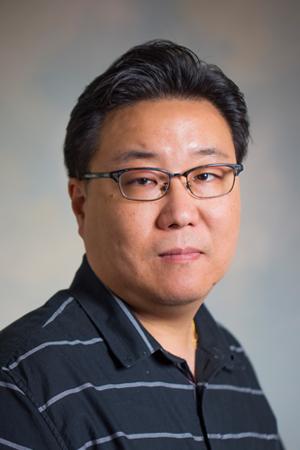
|
|
|
ICMT Authors win 2026 Ivy Parker Best Paper Award
|
The article "The Investigation of Iron Dissolution Mechanism in Acidic Solutions with and without Dissolved CO2-Part I: Electrochemical Impedance Spectroscopy Measurements"
was developed from research conducted in three labs around the world, based in the U.S. and in France, with seven authors involved.
Negar Moradighadi, Huiru Wang, Luntao Wang, and Srdjan Nesic from the Institute for Corrosion and Multiphase Technology with Antoine Seyeux,
Alain Pailleret, Philippe Marcus, from the Institut de Recherche de Chimie Paris, are all to be honored by acceptance of the 2026 Ivy Parker Best Paper in
CORROSION journal Publication Award. This research significantly advanced the understanding of anodic iron dissolution in chloride-containing acidic solutions,
particularly in the presence of dissolved CO2. These findings are critical for developing more accurate mechanistic models to predict and mitigate corrosion
in oil and gas transportation systems and other industries utilizing mild steel in CO2-containing aqueous environments.
The award is well deserved and recognizes the dedication, innovation, and exceptional contributions to the corrosion community.
The award will be given during Honoree Night at the AMPP Annual Conference and Expo on Wednesday, March 18, 2026, in Houston, Texas.
|
|
|
Visit from Collaborators at LISE, Sorbonne Université (France)
|
The ICMT was delighted to host Dr. Hubert Perrot and Dr. Alain Pailleret from LISE, Sorbonne Université, Paris, during their visit to Athens following their participation at the 248th ECS Meeting in Chicago. This visit further strengthened the long standing collaboration between the two laboratories; ICMT and LISE. At ECS, ICMT postdoctoral researcher, Dr. Kushal Singla, presented his work titled "Investigation of Head Group Influence on Adsorption of Organic Corrosion Inhibitors Using Quartz Crystal Microbalance with Dissipation Monitoring and Atomic Force Microscopy." This study was conducted in collaboration with the LISE group, highlighting the strong and productive partnership between our institutions.
During their two-day stay (October 20-21), our guests toured ICMT facilities, met with students and researchers, and discussed potential avenues for future collaboration. They also delivered talks in the Chemical and Biomolecular Engineering Department Seminar Series, where:
1: Dr. Perrot presented "The Quartz Crystal Microbalance for Studying the Durability of Materials."
2: Dr. Pailleret presented "Time- and Space-Resolved Characterisation of Metallic Material/Electrolytic Solution Interfaces: Towards the EC-AFM-QCM Coupling."
We look forward to continued collaboration and knowledge exchange with our colleagues from LISE in the exciting field of corrosion science and materials electrochemistry.
|

|
|
|
Exploring High Temperature Corrosion at the Gordon Research Conference
|
This summer, from July 19 to July 25, 2025, Zhuldyz Zhigulina and Kamila Turganova, senior PhD students, had the opportunity to attend the Gordon Research Conference on High Temperature Corrosion,
held in New London, NH. The conference brought together leading scientists, engineers, and graduate students from around the world to discuss the latest advancements in corrosion science in extreme conditions.
The presentations focused on various topics, including oxide scale formation and its interaction with alloy substrates, mechanisms of high-temperature alloy oxidation,
and the relationship between alloy microstructure and corrosion performance. Particular emphasis was placed on corrosion challenges in aggressive environments,
such as molten salt in nuclear reactors and harsh conditions encountered in aerospace, turbine, and engine systems.
|
|
|
Battling natural forces, advancing the industry and protecting the environment: OHIO's corrosion institute remains a world leader
|
Ohio University's corrosion institute has been solving corrosion-based problems and advancing the industry since 1993.
The Institute for Corrosion and Multiphase Technology (ICMT) is a world leader in conducting corrosion research and the largest corrosion research facility of its kind in the world.
|
|
|
ICMT Recognition at the AMPP Annual Conference + Expo 2025
|
We are pleased to announce that ICMT had multiple honorees, from undergraduate to senior faculty, at the largest and most significant gathering of corrosion practitioners, engineers and researchers, the AMPP Annual Conference + Expo 2025 in Nashville.
ChemE Senior Tyler Peoples, who has been engaged in corrosion inhibition research with us, was awarded the Oliver Moghissi Memorial Scholarship. He is currently continuing led by Dr. Marc Singer and Dr. David Young.
ICMT graduate student Favour Bawa won the 2nd place in the Mars Fontana category for her poster "Water Wetting Criteria to Assess Corrosion Risk in Two-Phase CO2-Water Pipeline Transport". She is currently engaged in PhD research within our ongoing CCT-JIP, led by Dr. Yoon Seok Choi.
Recent PhD graduate, Kushal Singla, was recognized as the recipient of the 2025 Annual Conference + Expo Publication Award. This recognizes the most impactful nominated paper at AMPP's Annual Conference, "Adsorption of Model Inhibitor Compound Characterized Using Quartz Crystal Microbalance with Dissipation Monitoring". In this groundbreaking research, he demonstrated that his adsorbed layer of quat-type corrosion inhibitor molecules behaves as a rigid mass. His PhD supervisor was Professor Srdjan Nesic and he worked within the CC-JIP led by Dr Bruce Brown, both of whom are co-authors on the paper. Kushal is currently a post-doc in ICMT.
Dr Brown and Professor Tingyue Gu won the prestigious honor of AMPP Fellows. Dr Brown, a Research Professor at the ChE department leads our CC-JIP and serves as the Associate Director at the ICMT. Prof. Gu is a globally recognized leader in microbiologically influenced corrosion (MIC) research.
Each received their awards at the Honoree Night during the AMPP Annual Conference + Expo in Nashville Tennessee on April 9th, 2025.
|
|
|
Postdoctoral Research Associate (Pool Posting)
|
The Russ College of Engineering and Technology Institute for Corrosion and Multiphase Technology (ICMT) at Ohio University invites applications for the full-time,
benefits eligible position of Postdoctoral Research Associate. This is a one-year, grant funded appointment which may be renewed for an additional year dependent upon performance and continued funding.
Job responsibilities include:
1. Assists in coordinating sponsored projects by providing technical and research expertise in the area of CO2/H2S corrosion as related to oil and gas production and transportation as well as CO2 capture, sequestration and storage;
2. Assists with budget management and fund raising;
3. Takes part in research work as an active researcher on assigned projects;
4. Mentors graduate students at the ICMT to help them with experimental and modeling skills as well as analytical, electrochemical aspects of their work;
5. Organizes and supervises graduate student training in using the various analytical equipment and instrumentation;
6. Assists with setting up and maintaining analytical laboratory equipment which will include, but is not be limited to, SEM, optical microscopy, spectrophotometry, chemical analyses, and electrochemical testing.
|
More information can be found here
|
|
|
December 2024 MS & PhD Defenses
|
The month of December has seen the final three defenses of the year, adding to what has been amongst one of our busiest in terms of graduate students completing.
First up was Abdulmohsin Al Isaee, defending his MS thesis "Investigation of the Corrosion Mechanism of CO2 Transport Pipelines Steel Caused by H2SO4".
Supervised by Research Professor Yoon-Seok Choi, Abdulmohsin is the first of our graduate students to complete from the CCT-JIP.
He investigated X65 steel corrosion in concentrations of H2SO4 of up to 98%, with a focus on phenomena occurring associated with droplets on our newly developed coupled multielectrode array (CMA) system.
Abdulmohsin defended remotely, having recently started a position as a Chemical Engineer with OQ, formerly known as the Oman Oil Company, in Muscat.
Next was Mengqiu Pan, her PhD dissertation is titled "Simulation of Batch Inhibition Applied to Top-of-The-Line Corrosion Mitigation".
Supervised by Professor Marc Singer, she completed her PhD within ICMT's TLC-JIP. Working with both in-house synthesized and commercial formulations,
she focused on their persistency in associated with methodological development employing ICMT developed electrochemical probes designed and now validated for TLC conditions.
Mengqiu also defended remotely, having recently returned to China to commence her employment as a Technical Engineer with the Zhujiang Gas Company in Guangdong.
Finally, Shrirang Deshmukh defended on "Mechanistic Impact of Oxygen on Corrosion in Aqueous Systems"; supervised by Research Professor David Young.
He investigated electrochemical kinetics of oxygen reduction and other experimentally relevant reactions using potentiodynamic sweeps, linear sweep voltammetry, and cyclic voltammetry.
This elucidated an oxygen reduction mechanism involving interspecies interactions, revealing novel insights which have not been previously reported.
He has joined Clariant as an Application Scientist relating to product formulations and their testing.
|
|
|
Doctoral Defense Trifecta
|
Fall 2024 has been particularly eventful in terms of the number of ICMT graduate students completing their PhDs.
First up was Neda Norooziasl, advised by Prof. Marc Singer. Her dissertation research was on "Effect of Oil/Water Wetting on CO2 Corrosion Behavior".
Recognizing how flow regimes can influence surface wetting in oil/water systems, she investigated how representative surface active compounds could play governing roles in associated corrosion phenomena.
Her research significantly enhanced our understanding of intermittent wetting effects on corrosion, offering invaluable insights for developing more effective mitigation strategies.
Neda has joined BP as a Materials & Corrosion Engineer located in Houston, Texas; developing and implementing corrosion management strategies for upstream, downstream,
and new energy facilities to ensure asset integrity and operational reliability.
Next was Kushal Singla. Building on our groundbreaking work on inhibition, his dissertation is on "Characterization of Corrosion Inhibitor Adsorption using Quartz Crystal Microbalance with Dissipation".
Working in collaboration with Dr. Hubert Perrot of Sorbonne University in Paris and advised by Prof. Nesic, he applied quartz crystal microbalance methodologies to build on, and validate,
foundational research employing atomic force microscopy to quantify molecular adsorption. His work serves as a link for integration of defined inhibitor adsorption phenomena into corrosion prediction models.
Kushal is continuing as a post-doc within ICMT's CCT-JIP.
Finally, Sahithi Ayyagari defended on "Role of Organic Acids in the Initiation and Propagation of Localized Corrosion of Mild Steel in Aqueous CO2 Environments"; also advised by Prof. Nesic.
Resolving the roles of weak acids in aqueous corrosion environments is of key importance to the oil and gas industry given their ubiquitous nature,
her focus being on their impact on forming/formed FeCO3 layers relating to complexation effects. Sahithi has joined ChampionX as a Principal Chemist located in Sugar Land, Texas;
focusing on electrochemical and corrosion performance testing to deliver tailored solutions that enhance asset reliability and ensure long-term corrosion protection.
|
|
|
Lukas Johansson Defends MSChE Thesis
|
Lukas Johansson successfully defended his thesis entitled "Development and Modeling of Flowtube Apparatus for Conducting Corrosion Experiments" on November 7, 2024.
Lukas had completed his research work at the ICMT and began working as a Principal Radiation Protection Specialist at Westinghouse Electric Company in 2022.
His continued progress to complete his thesis while working a full-time job is commendable. Congratulations Lukas!
|
|
|
Seminar at Colorado School of Mines
|
Dr. Yoon-Seok Choi was invited as a guest lecturer to give a seminar in the Department of Metallurgical and Materials Engineering at Colorado School of Mines on October 24th, 2004.
His lecture was on "Confronting Corrosion Challenges in the Oil & Gas Industry and Carbon Capture & Storage (CCS) Processes". The details and abstract for the talk are available
here
|

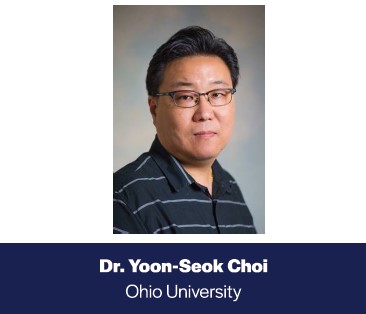
|
|
|
The Corrosion Center JIP Fall 2024 Advisory Board Meeting
|
The Corrosion Center JIP Fall 2024 Advisory Board meeting was held October 9th and 10th.
There were 9 company representatives from our 13 sponsoring companies in attendance for the 2 day meeting.
Included in the 12 presentations from students and staff over the two-day mini conference was a guest presentation from Steve Smith,
Adjunct Professor at Ohio University, on Oilfield Metallurgy - 101, which was well received by all who attended.
The photo above was taken outside of the ICMT during the first day of presentations. Feedback from the representatives during the Members'
Review meeting were very positive and we look forward to meeting online in January and in person again in May 2025. For sponsors of the CC JIP -
recordings of all presentations are available on the secure server for you to view and share in your company.
|
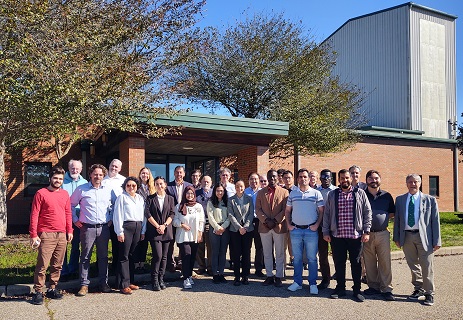
|
|
|
Roundtable discussion and two Corrosion Journal articles available for review
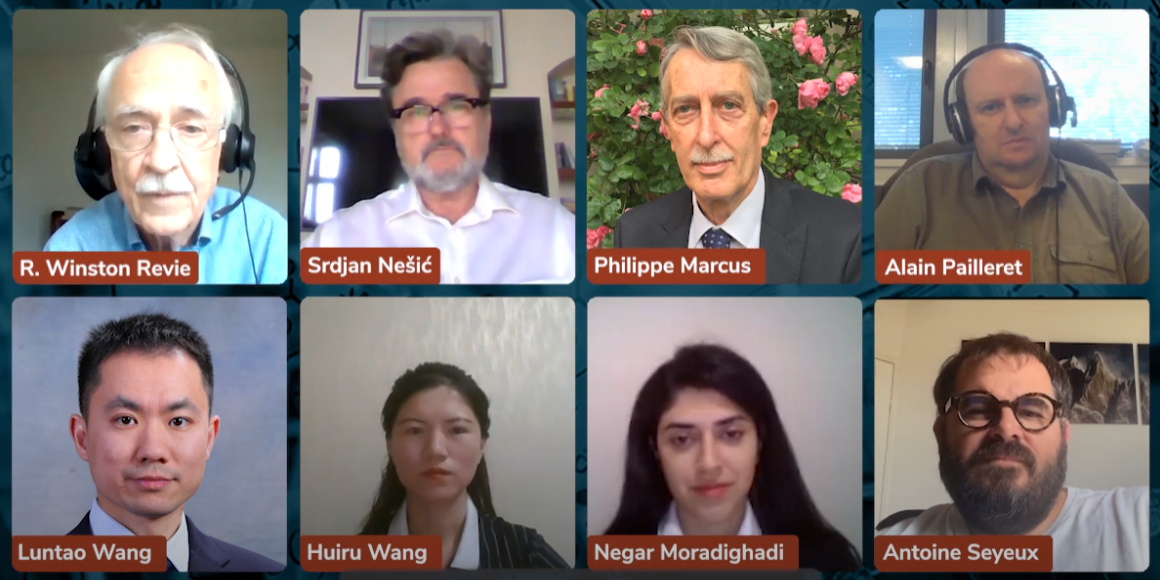
|
|
On July 1st, a two-part series on Investigation of Iron Dissolution Mechanism in Acidic Solutions with and without Dissolved CO2 was published in the July 2024 edition of the Corrosion Journal.
These two open access articles are currently available for download and review. On July 10th, Winston Revie, an associate editor for CORROSION journal,
led a roundtable discussion about the recently released two-part paper series which was based in three labs around the world. The seven authors are the following Negar Moradighadi (ICMT, Ohio Univ);
Huiru Wang (ICMT, Ohio Univ); Luntao Wang (ICMT, Ohio Univ & Universit� PSL, CNRS); Antoine Seyeux (Universit� PSL, CNRS); Alain Pailleret (Sorbonne Universit�, CNRS);
Philippe Marcus (Universit� PSL, CNRS); Srdjan Nesic (ICMT, Ohio Univ).
The background and the descriptions of the research provided during the roundtable discussion provide an in-depth understanding of the journal papers which is a benefit to all readers.
YouTube - Corrosion Journal July Roundtable
You can read both parts on corrosionjournal.org or by clicking the following:
Part 1 - DOI-10.5006/4511
Part 2 - DOI-10.5006/4512
|
|
|
Yi He Selected as OHIO's 2024 Outstanding Chemical Engineering PhD Student
|
Congratulations to Yi He upon her receiving the Gustavus Edward and Gladys V. Smith Memorial Engineering Award,
recognizing her as the Department of Chemical & Biomolecular Engineering's outstanding PhD student.
She was presented with her award plaque at the Russ College 2023-2024 Student Awards Ceremony, hosted by the Russ College chapter of Tau Beta Pi, the engineering honor society.
Yi's dissertation research topic was the "Effect of Intermittent Wetting on Corrosion Inhibition in Oil/Water Systems", Dr. Marc Singer was her academic advisor.
She presented at least biannually to her project sponsor, TotalEnergies, as a member of a collaborative team. She has 6 peer reviewed journal papers in Corrosion,
Journal of the Electrochemical Society, Equipment Environmental Engineering, and Corrosion Science; other manuscripts are in various stages of the review process.
She is a co-author on 6 conference proceedings and presented papers and posters at each of the AMPP conferences from 2021 to 2024, taking 3rd place in the Mars Fontana Category in 2022.
|
|
|
CC JIP 30th Anniversary Awards Dinner
|
At the CC JIP 30th Anniversary Awards Dinner, we wanted to formally thank our dedicated sponsors for their support of our research over these 30 years (1993 to 2023).
Over the last 30 years, over 40 companies have sponsored the CC JIP, and more than half of those companies have provided funding for 5 or more years. Fourteen awards were given at the event.
View the full article and photo's here.
|
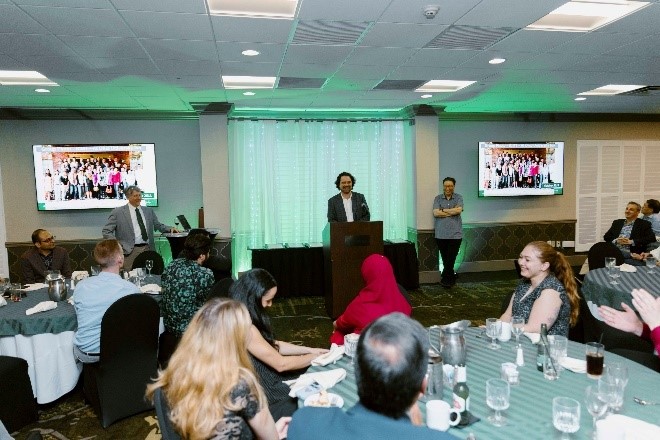
|
|
|
Spring 2024 PhD Defenses: Yi He & Ishan Patel
|
Yi He and Ishan Patel are the latest ICMT PhD students to defend their dissertations.
Yi's research topic was, "Effect of Intermittent Wetting on Corrosion Inhibition in Oil/Water Systems".
Understanding wetting phenomena is key to understanding corrosion itself, and how it can be mitigated.
Stemming from her research, she has over 10 publications as conference proceedings papers and peer reviewed journal articles;
including in CORROSION, Corrosion Science, and The Journal of the Electrochemical Society. Advised by Prof. Marc Singer,
she performed her research within our corrosion inhibition focused project working with TotalEnergies. She is continuing research within ICMT.
Ishan Patel performed his research within ICMT's long-standing NAP-JIP, his dissertation work was on,
"Modelling and Simulation of High Temperature Naphthenic Acid and Sulfidation Corrosion". He has manuscripts currently going through the peer review process,
as well as several AMPP conference proceedings papers. He worked closely with NAP-JIP Project Leader Dr Gheorghe Bota, his advisor being Research Professor David Young.
Ishan will be joining NETL as an ORISE post-doc.
|
|
|
CC JIP Spring Advisory Board Meeting
|
The Corrosion Center JIP Spring 2024 Advisory Board meeting was held April 17th and 18th. There were 19 company representatives from 8 of our sponsoring companies and 2 visiting companies.
Included in the 14 presentations from students and staff over the two-day mini conference was a guest presentation from Fred Ruiz,
Coastal Chemical, on Surface H2S Applications and Chemistry Discussion. The photo above was taken outside of the ICMT during the first day of presentations.
Feedback from the representatives during the Members' Review meeting were very positive ("The team is awesome!") and we look forward to meeting online in June and in person again in October.
|
|
|
|
CCT JIP Spring Advisory Board Meeting
|
The Corrosion in CO2 Transmission Pipelines (CCT) JIP 2024 Spring Advisory Board Meeting was held on April 15th and 16th. There were 27 company representatives (in person and online) from 15 of our sponsoring companies.
|
|
|
|
Visit to ICMT
|
March 8, 2024
Hisashi Amaya, Kyohei Kanki, Atsushi Sohma (Nippon Steel), and Matteo Fiocchi (S&L Consulting) visited ICMT to discuss the ongoing research project about corrosion of CO2 injection tubing materials.
|
|
|
|
ICMT Recognition at AMPP2024
|
Current ICMT students and alumni had noteworthy recognition at AMPP2024 in New Orleans.
Neda Norooziasl and Yi He, both in the final stages of completing their PhDs,
each received the AMPP Graduate Student Book Award.
ICMT PhD students also took top places in different poster award categories. Kasra Shayar Bahadori took 1st in the Fontana category,
which focuses on corrosion science, for "Methodological Development for Corrosion Inhibitor Persistency Studies",
with Adam Cutright placing 3rd with "CFD Simulations of Strong Acid and CO2 Corrosion in Various Flow Geometries". Sahithi Ayyagari secured 2nd in the Pourbaix category,
for corrosion engineering, with "Influence of Acetic Acid on the Protectiveness of Iron Carbonate Layers".
ICMT alum Francois Ayello, PhD 2010,
was also recognized for his contributions to the field of corrosion and its prevention by being named an AMPP Fellow. Francois is a Principal Engineer with DNV.
Thu Tran Addis, PhD 2014, received the AMPP2024 Early Career Excellence Award. Thu is a Corrosion Engineer with BP.
Former ICMT post-doctoral researcher and Top-of-the-Line Corrosion JIP project leader Zineb Belarbi, also received AMPP's Joyce Wright Industry Impact Award,
which recognizes women for "creating a positive impact on the culture of the materials protection and performance industry, mentoring, and providing wisdom to others in the industry".
She is a Corrosion & Materials Scientist at National Energy Technology Laboratory, Task Lead for Pipeline Material Technologies.
|
|
|
|
Srdjan Nesic on the Knowns and Unknowns of CO2 Corrosion: February's CorroZoom Webinar
|
ICMT Center Director Srdjan Nesic will be presenting the next CorroZoom webinar on 20th February.
Speaking on "Corrosion of Carbon Steel in Aqueous CO2 Environments - the Known Knowns and the Known Unknowns",
he will present on the state-of-the-art on this topic, which is of key importance to the energy industries;
from oil and gas production to carbon capture. Registration is required at Zoom
The abstract for his presentation reads as follows:
"The known knowns: gaseous CO2 is stable, mostly inert and non-corrosive.
However, upon dissolution in water and a subsequent hydration, a more reactive chemical species - carbonic acid, is formed,
which then partially dissociates to form an acidic solution, corrosive for carbon steel. Due to partial dissociation,
these kinds of aqueous solutions are called weak acids, even if there is nothing weak about them when it comes to corrosion.
Actually, aqueous CO2 solutions are more corrosive than strong acid solutions at the same pH. A lot is known about corrosion of carbon steel in aqueous CO2 solutions:
the water speciation, the electrochemistry of cathodic and anodic reactions, the formation of protective layers, the most influential factors, etc.
Over the past 50 years a vast body of knowledge was generated in this field, mostly driven by the challenges coming from the oil and gas industry,
where the hydrocarbons that emerge from the ground are always accompanied with some CO2 and water, making internal corrosion of carbon steel facilities a large problem.
Wells, pipelines, processing and distribution facilities are all affected.
The known unknowns: removal of anthropogenic CO2 from the atmosphere and its capture at the source is one of the largest scientific and engineering challenges facing humanity in the 21st century.
If this CO2 is to be safely transported and stored underground, it must be compressed to pressures where it is in liquid or supercritical form.
Even very small amounts of water, SOx and NOx (in the ppm range) can lead to catastrophically high internal corrosion rates of transportation and injection facilities made from carbon steel.
Little is known about this type of corrosion and the understanding we have about aqueous CO2 corrosion of carbon steel does not carry over entirely."
Now in its 4th season, CorroZoom is a free webinar series administered by Prof. Gerald Frankel of The Ohio State University's Fontana Corrosion Center.
Further information on CorroZoom, including webinar slides and recordings from past events, can be accessed at OSU.
UPDATE - A recording of Prof. Nesic's presentation can be accessed here: FCC OSU Webinar.
|
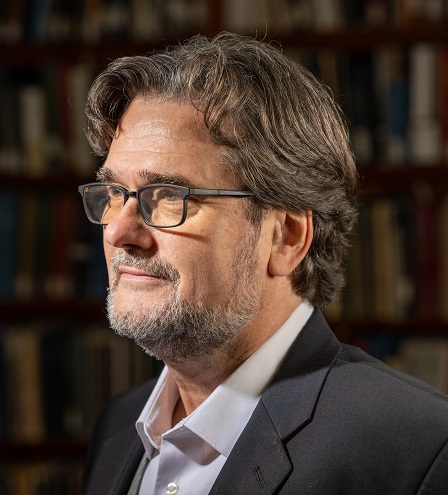
|
|
|
|
Dr. Nesic makes a presentation at UNAM (Universidad Nacional Aut�noma de M�xico)
Department of Metallurgy on January 24, 2024
|
To see the talk follow this link: Youtube
|
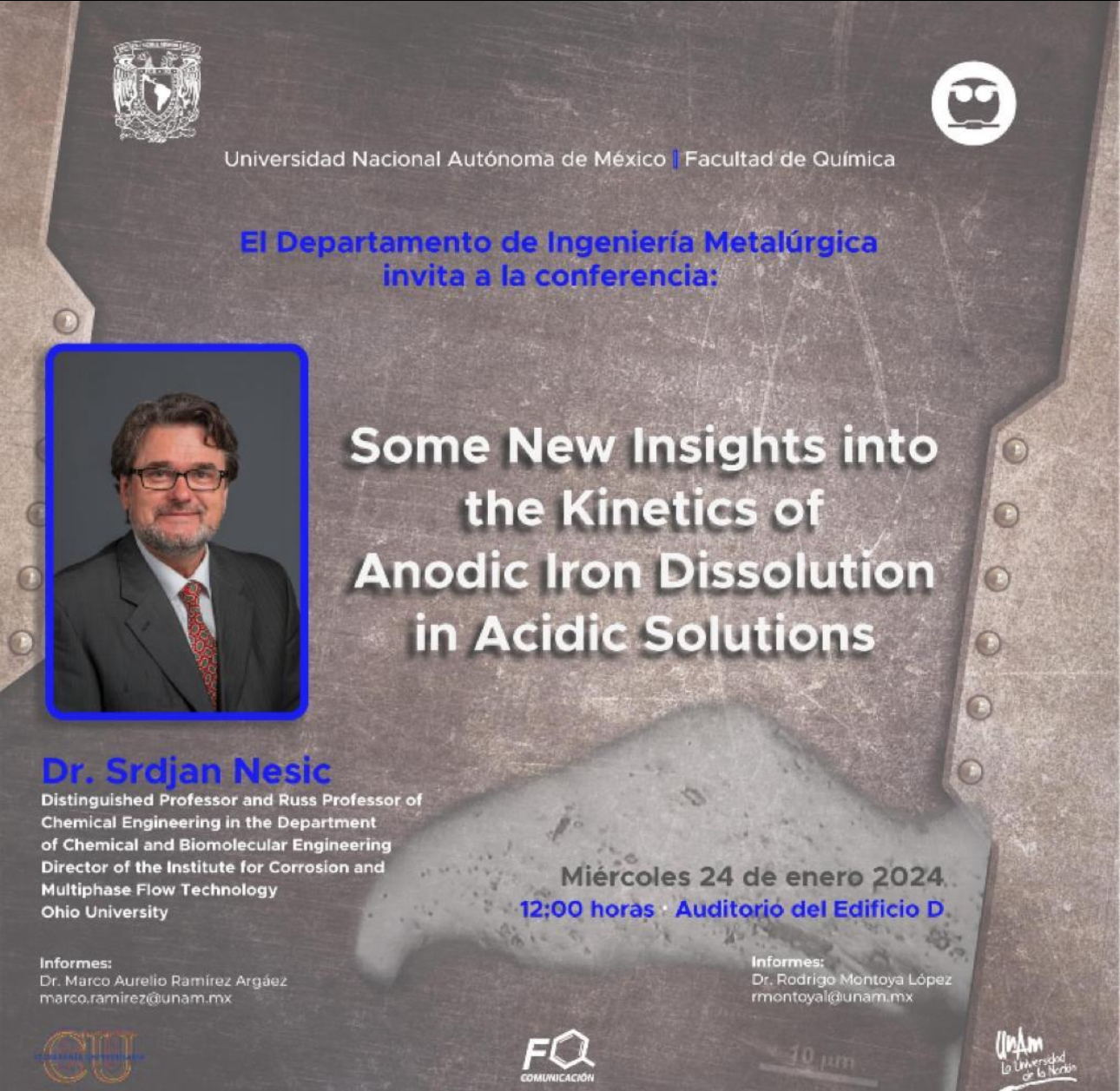
|
|
|
|
ICMT Article Featured in Corrosion
|
"Effect of Oil/Water Intermittent Wetting on CO2 Corrosion in the Presence of Acridine and Myristic Acid" featured as editor's choice open access article for Corrosion. View the Article here: (CORROSION (2024) 80 (1): 102-112)
|
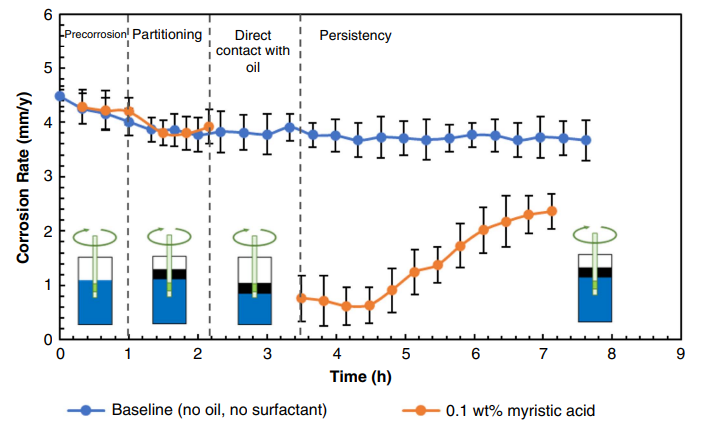
|
|
|
|
Drew Trommer and Shuai Ren Latest ICMT Alums
|
Drew Trommer and Shuai Ren have officially graduated, making them our most recent alums.
Drew completed his MS degree on "The Effect of Organic Acids on Hydrogen Sulfide Corrosion of Mild Steel",
he worked within our Corrosion Center Joint Industry Project; his advisor was Research Professor David Young.
Manuscript preparation is ongoing, with publication scheduled for Fall 2024 in line with CC-JIP policy.
He has started a position as a Metallurgist with Element Materials Technology.
Shuai's PhD was on "Effect of Corrosion Residues and Products of Mild Steel on Corrosion Inhibition Mechanisms in CO2 and H2S Environments",
conducted within our corrosion inhibition project with TotalEnergies; his research focused on Fe3C, FeCO3,
and FeS interacting with our in-house synthesized pyrimidinium and phosphate ester model compounds as well as commercial corrosion inhibitors.
To date, he has 10 publications, as either peer reviewed journal papers or conference proceedings, from his research within ICMT.
His advisor was Professor Marc Singer. He has commenced employment as a Materials Scientist with Halliburton.
|
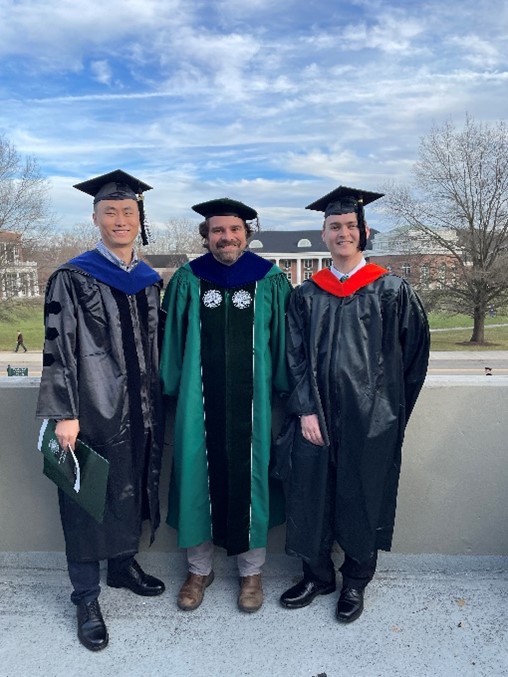
Shuai Ren, Prof. Marc Singer, and Drew Trommer after graduation.
|
|
|
|
Shrirang Deshmukh Makes it 2-in-a-Row
|
Mid-November marks Ohio University's International Education Week, and its Student Global Research Symposium.
In 2022, ICMT PhD student Yi He took first place in its associated 3-Minute Thesis competition.
This year, ICMT's Shrirang Deshmukh (SD) repeated the win taking the $500 prize, presenting on "The Effect of Oxygen on Corrosion in the Oil and Gas Industry".
He narrowly beat out fellow finalist and ICMT PhD student Zhuldyz Zhigulina, who presented on "Insight into High Temperature CO2/H2S Corrosion of Mild Steel".
This is a terrific achievement for both, and recognition of ICMT research in the broader OHIO community.
|
|
|
CC JIP 2023 Fall Meeting October 24-26
|
The 2023 Fall meeting of the CC JIP was held on October 24-26 at ICMT in Athens, OH.
In attendance were 14 representatives from 9 of our current sponsoring companies while more representatives from our other sponsoring companies joined us in real time online.
Over the 2 � day event, our students and staff provided 16 presentations for review and discussion.
An update to MULTICORP V6.0 was released prior to this meeting and was reviewed on Thursday after the member's meeting.
As usual, many great in-depth discussions occurred during the meeting with positive feedback for the current research directions. The photo below shows attendees from this event:
|
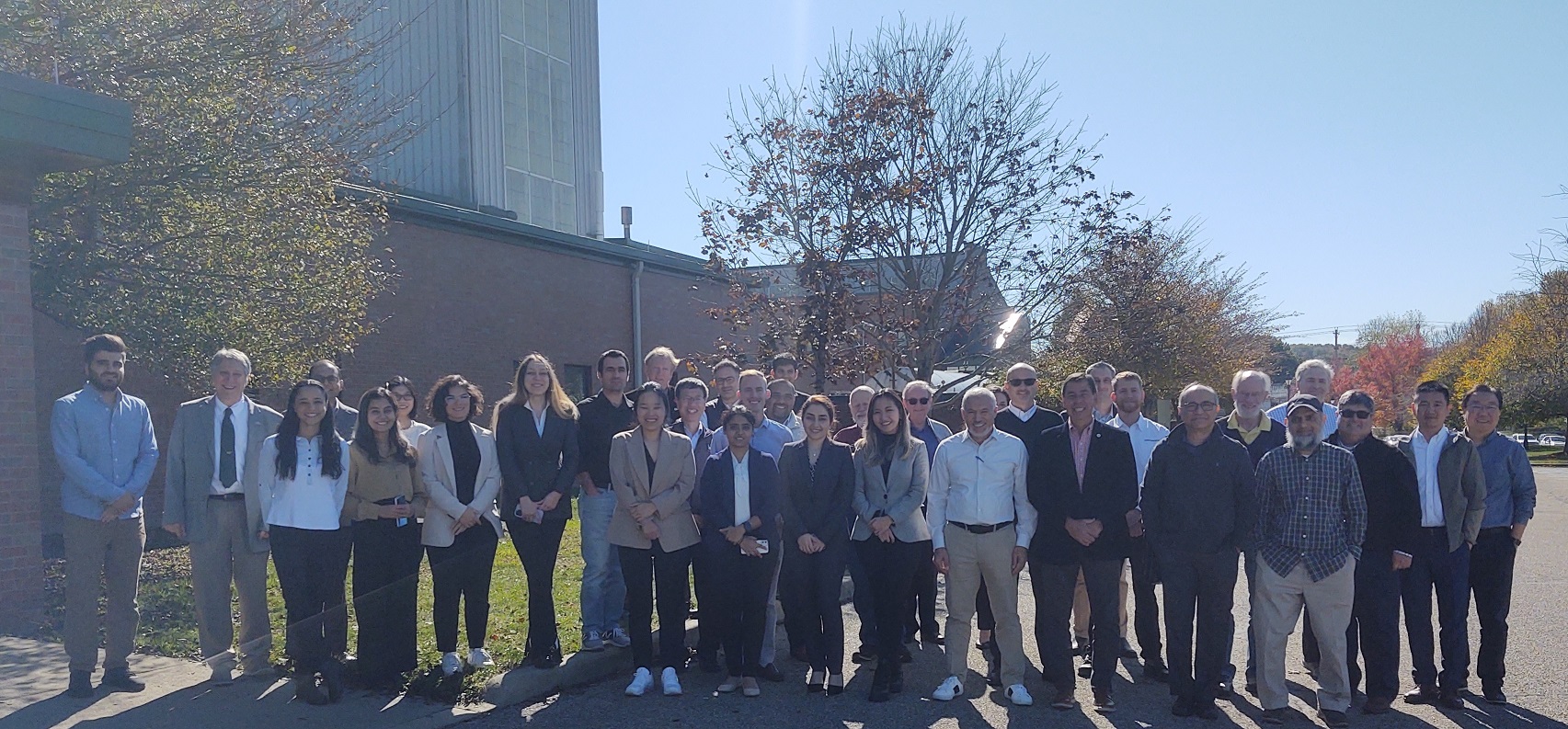
|
|
|
President, Provost & Dean
|
Ohio University President Lori Stewart Gonzalez, Provost Elizabeth Sayrs, and Russ College of Engineering & Technology Dean Patrick Fox made a combined visit to our laboratory.
They learned about the three-decade history behind ICMT, our ongoing activities, and future plans. They then toured the laboratory floor,
were shown key items of equipment employed in corrosion testing. Our PhD students Shrirang Deshmukh, Adam Cutright, Ishan Patel, Neda Norooziasl, Kamila Turganova,
Zhuldyz Zhigulina, Yi He, and Martin Colahan showcased their research in a poster format, demonstrating the diversity of our research activities.
University photographer Eli Burris cataloged the visit, and we thank him for the pictures below.
|
|
|
Payman Sharifi Abdar Doctoral Defense
|
PhD student Payman Sharifi Abdar has successfully defended his dissertation research, "Mechanism and Modeling of Galvanic Corrosion between Mild Steel and Iron Sulfides in Acidic Solutions".
Research within ICMT previously demonstrated that formation of different types of iron sulfides as corrosion products were a main culprit in localized attack,
due to their wide-ranging physicochemical properties. Galvanic coupling between such iron sulfide layers and mild steel was suspected to be associated with the observed localized attack.
The two types of iron sulfides investigated by Payman, pyrite and pyrrhotite, were shown to produce different galvanic corrosion due to their distinct electrochemical behaviors.
To further elucidate the mechanism of the impact of iron sulfide type, the cathodic behavior of pyrite and pyrrhotite was systematically studied using a rotating disk electrode system.
The results revealed that pyrrhotite has significantly higher cathodic current than pyrite. This difference originates from different cathodic reactions occurring at the surface of these iron sulfides.
Manuscripts are in preparation relating to his findings. He has previously published in Electrochimica Acta and Analytical Methods. He has been a regular attendee at NACE and AMPP conferences,
receiving 2nd place in the Mars Fontana Category for his research poster at CORROSION 2021.
Payman's PhD advisor was University Distinguished Professor, and ICMT Director, Srdjan Nesic.
He recently started a post-doctoral researcher position in the University of Pittsburgh's Department of Chemical & Petroleum Engineering, with an electrocatalysis research focus.
|
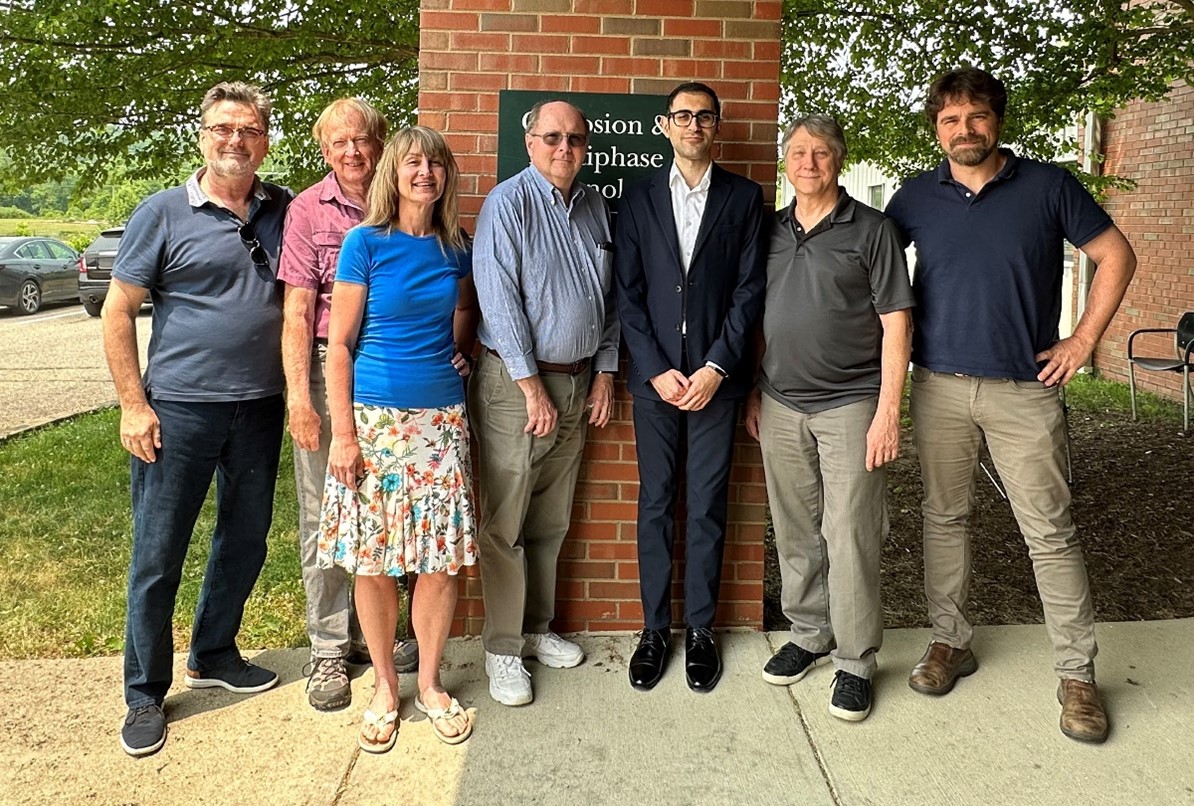
Post-defense, Payman with his committee members and project leaders.
|
|
|
Mohiedin Bagheri PhD Defense
|
ICMT PhD student Mohiedin Bagheri has successfully defended his dissertation research, "Mechanism of Anodic Dissolution of Iron and Steel in CO2 Environments".
His research focus was the mechanistic investigation of the multistep reaction that occurs during CO2 corrosion.
After critical review of the fundamental theories underpinning the oxidative dissolution reaction, he developed a simpler narrative that was successfully applied in corrosion modelling.
Furthermore, has research yielded important insights into how specific environmental factors (e.g., pH, dissolved CO2, temperature, steel type, etc.)
can mechanistically impact kinetics of elementary steps, and ultimately the overall reaction of iron dissolution. His advisor was Professor Srdjan Nesic,
his committee members were Professor Howard Dewald, Associate Professor Katherine Cimatu, Associate Professor Marc Singer and Research Associate Professor Yoon-Seok Choi.
Mohiedin holds a MS degree in Chemical Engineering, also from OHIO, as well as BSc and MSc degrees in Materials Science & Engineering from Sharif University of Technology.
He has published in the peer reviewed journals Advanced Materials, Materials & Design, Journal of the Electrochemical Society, Materials Science & Engineering,
Australian Journal of Chemistry, Electrochimica Acta, and Analytical Methods. He will be joining OLI as an Electrolyte/Corrosion Simulation Specialist.
|
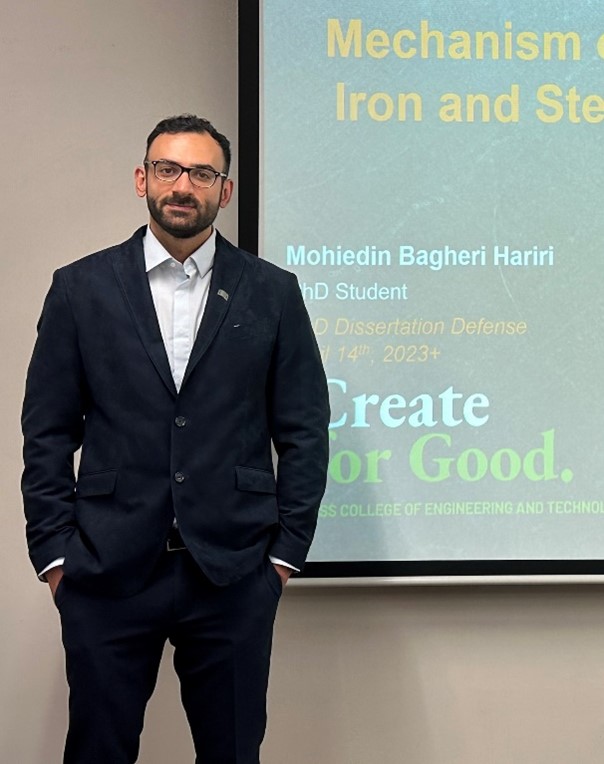
|
|
|
Russ Outstanding Research Paper Award for 2022:
“Machine learning modelling of time-dependent corrosion rates of carbon steel in the presence of corrosion inhibitors”
M. Aghaaminiha, R. Mehrani, M. Colahan, B. Brown, M. Singer, S. Nesic, S. Vargas, and S. Sharma, Corrosion Science, 193 (2021)
|
The Russ Outstanding Research Paper Award recognizes excellence in research and scholarship exhibited by the faculty of Russ College and is awarded by recognition from a committee consisting of previous award recipients.
(For more information click here.)
The team chosen for the award at the Institute for Corrosion and Multiphase Technology focused their efforts on modeling experimental data obtained from a series of experiments
on corrosion inhibition of mild steel in CO2 saturated aqueous solutions. Regression analysis was performed using different ML algorithms (Artificial Neural Network,
Random Forest, Support Vector Machines, and K Nearest Neighbors) to model experimental data of time-varying corrosion rates of mild steel specimens when corrosion inhibitors
were added to the system in different concentrations and dose schedules and with and without pre-corrosion. One of the main conclusions was that the sensitivity of corrosion
rates to changes in the environmental variables could be well-predicted by the trained RF model, which can eliminate the need to perform extensive experiments for different
solution conditions in the lab. The paper can be found
here.
|
|
|
ICMT Grad Student Recognition at OU’s EXPO 2023
|
Every Spring semester, Ohio University stages its Student Research and Creative Activity Expo. As usual, ICMT had multiple graduate students showcasing their research on the floor
of our campus’s Convocation Center.
Presenting his poster on Inhibitor Adsorption Characterized using Quartz Crystal Microbalance, Kushal Singla took 1st place in the Special Session
Awards conferred by the University International Council. Yi He also took 1st place for Effect of Intermittent Wetting on Corrosion Inhibition in Oil/Water Systems with the Best Content
Award by the Graduate Student Senate.
Adam Cutright took 2nd place in ChemBioEng2 with Impact on Corrosion and Corrosion Product Layers by Trace Concentrations of H2S, Martin Colahan took 2nd place in ChemBioEng1 on
Development of a Downhole Corrosion Modeling Software, and Shrirang Deshmukh also took 2nd with Anomalies Associated with the Oxygen Reduction Reaction.
The Expo is an excellent event where undergraduate and graduate students can also network, see each other’s research, and exchange ideas. A highlight in OHIO’s calendar!
|
|
|
Huiru Wang Recognized as OHIO's 2023 Outstanding Chemical Engineering PhD Student
|
Hearty congratulations to Huiru Wang upon her selection for the Gustavus Edward and Gladys V.
Smith Memorial Engineering Award, recognizing her as the Department of Chemical & Biomolecular Engineering's outstanding PhD student.
Along with a monetary component, she will be presented with a plaque for the award at the Russ College 2022-2023 Student Awards Ceremony
and luncheon on April 22 from 11:00am to 3:00pm at the Ridges Auditorium, hosted by the Russ College chapter of Tau Beta Pi, the engineering honor society.
|
|
|
ICMT at the 2023 AMPP Annual Conference
|
As is our norm, ICMT sent a healthy contingent to the AMPP Annual Conference in Denver.
In total, 18 presentations were made and 17 posters displayed. Symposia participated in covered Corrosion Control with Inhibition,
Progress in Laboratory Testing of Corrosion Inhibitors, Sweet and Sour Corrosion, VCI Applications, Corrosion in Supercritical Systems,
Machine Learning, Mechanisms of Localized Corrosion, Refining Industry Corrosion, RIP, and Electrochemical Techniques.
ICMT PhD students were also recognized by AMPP. Sahithi Ayyagari and Kushal Singla each received the Graduate Student Book Award,
with Sahithi also receiving the Oliver Moghissi Memorial Scholarship. Kushal along with Neda Norooziasl were also selected for the AMPP Member Leadership Development Program.
Recent ICMT research scholar Bernardo Santos, who we count as one of our own, was awarded the AMPP Diversity and Inclusion Grant.
Internal planning is already underway for our participation in the 2024 AMPP Annual Conference in New Orleans.
|
|
|
ICMT Duo Huiru Wang and Luntao Wang Publish Groundbreaking ToF-SIMS, XPS Manuscript
|
During their research at Universit� PSL and Sorbonne Universit�, recent ICMT PhD Huiru Wang and current post-doc Luntao Wang collaborated on a surface analysis investigation
that is now published in Corrosion Science, "Adsorption mechanism of quaternary ammonium corrosion inhibitor on carbon steel surface using ToF-SIMS and XPS".
In their groundbreaking work, they combined Time-of-flight secondary ion mass spectrometry (ToF-SIMS) and X-ray photoelectron spectroscopy (XPS) to characterize adsorption
phenomena associated with the corrosion inhibitor molecule
tetradecylbenzyldimethylammonium on a mild steel surface. They demonstrated that the adsorbed inhibitor surface coverage strongly depends on immersion time and inhibitor
concentration, with a maximum as well as uniform coverage is found for sufficiently long exposure times at a critical inhibitor concentration of ca. 25 ppmw.
The uniform adsorbed inhibitor layer formed on the surface was determined to mitigate the formation of iron chloride/hydroxide intermediates, thus enhancing the corrosion
protection of carbon steel in aggressive environments. The manuscript can be accessed here: (ScienceDirect.com).
|
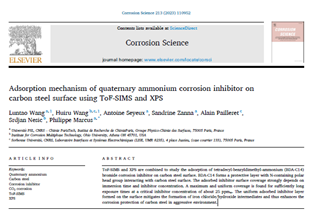
|
|
|
|
|
|
|
|
|
|
|
|
|
|
|
|
|
|
|
|
|
|
|
|
| FEATURED NEWS/ARTICLE |
- Corrosion Journal two-part series on Investigation of Iron Dissolution Mechanism in Acidic Solutions with and without Dissolved CO2, published on July 1, 2024,
and reviewed by roundtable discussion are available as open access documents:
Part 1 - DOI-10.5006/4511
Part 2 - DOI-10.5006/4512
- "Ohio University oil and gas corrosion researchers
author most downloaded, most cited journal articles" Article by Marissa McDaid, Feb 3, 2020.
- "Ohio University Research Moment with Dr. Nesic" Ohio University is home to one of the
largest research institute in the world that studies corrosion-particularly in oil and gas pipelines and Dr. Srdjan Nesic gave a brief introduction about our institute with Research Moment of Ohio University.
- "Adsorption behavior of organic corrosion inhibitors
on metal surfaces - Some new insights from molecular simulations" by S. Sharma, X. Ko, Y. Kurapati, H. Singh, and S. Nesic. Corrosion, Vol. 75, No. 1, pp. 90-105, 2019.
|
| SOFTWARE |
|
|
| UPCOMING EVENTS |
- CORROSION CENTER JIP
The Corrosion Center Joint Industry (CC JIP) Summer Quarterly Review will be held online and recorded.
CC JIP Review - Thursday, August 7, 8:30am-11:30am EST 
Contact Dr. Bruce Brown for more information.
- CORROSION CENTER JIP
The Corrosion Center Joint Industry (CC JIP) Fall Advisory Board Meeting will be held in Athens, Ohio,
at the Institute for Corrosion and Multiphase Technology building.
CC JIP meeting - November 18 & 19 (Tuesday & Wednesday - 2 Days) 
Contact Dr. Bruce Brown for more information.
- CORROSION IN CO2 TRANSMISSION PIPELINES (CCT JIP)
The Corrosion in CO2 Transmission Pipelines (CCT JIP) Fall Advisory Board Meeting will be held in Athens, Ohio,
at the Institute for Corrosion and Multiphase Technology building.
CCT JIP meeting - November 20 & 21 (Thursday & Friday - 1.5 Days) 
Contact Dr. Yoon-Seok Choi for more information.
|
ARCHIVED NEWS |
|
|
|
©2025 Ohio University. All Rights Reserved.
Institute for Corrosion and Multiphase Technology
Ohio University's Research and Enterprise Park
342 West State Street
Athens, Ohio 45701
United States of America
Telephone: +1-740-593-0283
Fax: +1-740-593-9949
[ Show Map ]
|
| | | | | | | | | | | | | | | |




